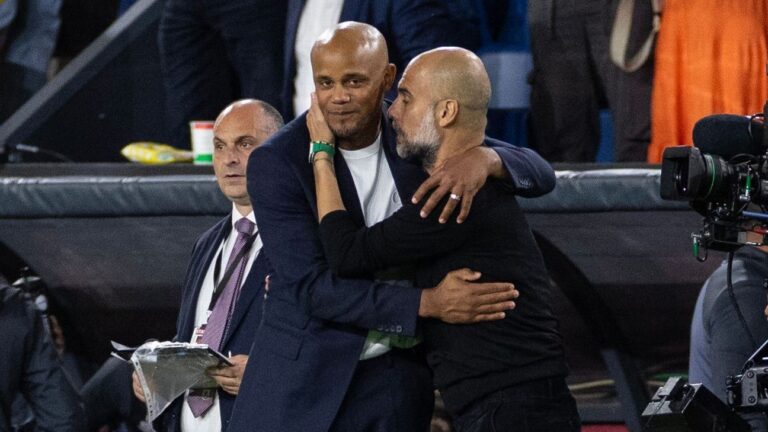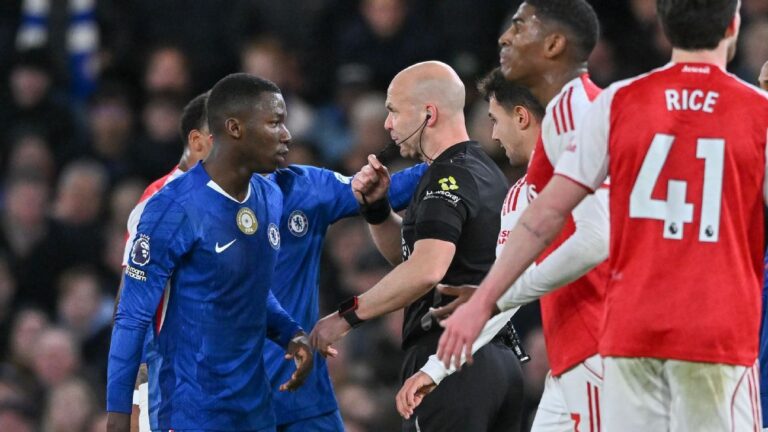Elite-level footballers are some of the highest-paid workers on the planet, which means their contracts are likely to be long, confusing and full of legal speak that might be difficult to understand for the general public. So here’s a guide to how they are put together.
Tor-Kristian Karlsen, a Norwegian football scout, formerly the chief executive and sporting director at Monaco, explains all.
– Stream on ESPN+: LaLiga, Bundesliga, more (U.S.)
Though the UK media typically report players’ wages in weekly terms, the vast majority of elite footballers receive their payslips on a monthly basis. That’s not to say exceptions don’t exist — the payment structure is entirely up to the club and the player — but it makes more sense financially.
The preference for stipulating weekly amounts could be a hangover from previous times when players were most commonly paid on a weekly basis. But in other countries — Italy, for instance — the media predominantly give yearly totals and cite net figures, whereas Premier League salaries are usually reported as gross (pre-tax).
Incentive-related payments come in all shapes and sizes. Many clubs stick to a set system whereby a certain amount is paid for a starting appearance and a smaller fee for coming off the bench (typically 30%-50% of being in the starting XI). Some savvy clubs may operate a minutes-based system for a substitute appearance, mainly to reduce the costs of tactical (or time-wasting) changes in the dying minutes of a game.
By and large, clubs have their own models to encourage good performance. But as the bonus schemes can be flexible — and often constitute the “minor details” that often hold up a new signing — a player’s agent will hold out for an appearance fee that ensures his client the quickest route to a windfall, whereas the CEO or the owner will insist on their existing structure.
Other personal bonuses — such as a clean-sheet bonus for a goalkeeper or defender, or assist/goal payments for an attacking player — do exist, but the big clubs tend to consider them an unnecessary expense. Having already negotiated win or point bonuses (personally or collectively), it’s unlikely to make a difference to a professional player who should be doing their utmost to do their job well anyway.
Achievement bonuses for reaching pre-agreed targets such as winning the league, cups or European qualification — or staying up for those with focus on survival — are more likely to be negotiated collectively, often with the team captain (or “captain group”) acting on behalf of the playing squad. In many cases, canny players can insert additional achievement payouts in their personal agreements, hence landing a handsome double whammy when silverware is collected.
Sometimes more novel agreements occur. An extra bonus for a Ballon d’Or nomination for a star signing — Man United were reported to have included one for Anthony Martial — may not be a major concession from a top club’s point of view, but it can raise eyebrows depending on the status of the player and their viability to win it at some point in their career.
A “Matching Highest Earner” clause may also be mooted around the negotiation table. Typically more of an issue at the top of the food chain, this arrangement sees the player in question granted improved wages equal to those of a new signing.
There are also occasionally big-name managers who want to ensure permanent top-earner status and will have this clause inserted in their own contracts. Of course, this could deter a club from targeting a star player they know would upset their existing wage structure, so it would have to be carefully thought out beforehand.
A player’s basic salary tends to stay the same unless they exceed expectations — in which case, rest assured, their agent will come knocking on the door for improved terms that are often backed up with an extension.
Unlike normal working contracts, footballers are not generally subject to inflationary yearly increases. Partly because the money is substantial enough anyway and partly because the contracts are limited to a relatively short timespan of a few years. Either a contract will get renegotiated, or new deals are thrashed out at another destination.
In short, transfer expenditure is levelled out over the whole contractual period. It’s called “amortisation.” This means a €100m signing, who joined on a five-year contract, will show up as a cost amounting to €20m in the yearly accounts (€12.5m across an eight-year deal.)
Transfer income (whether received upfront or in instalments), however, kicks in immediately on the books, generating a more manageable yearly result accounting-wise and thereby alleviating immediate financial fair play (FFP) concerns.
While the practice has proved controversial, Chelsea have acted well within their rights. UEFA, however, recently signalled its intention to reduce the amortisation period of a transfer fee to a maximum of five years.
With player contracts, add-ons generally refer to payments that go beyond the basic salary — be it bonuses (as outlined above), signing-on fees, or loyalty bonuses (typically activated as a one-off payment after a set number of completed contractual years as an incentive for the player not to seek a move elsewhere.)
Then there’s a long-standing tradition of agents wanting minor perks to be thrown into the contract at the 11th hour under the pretext of “if you want to make the player extra happy.” Examples include flights — often private jets these days — for friends and family, taking care of house moving costs, transporting beloved pets, and costs towards nannies or school fees for their children.
Add-ons also occur as an element to terms of a club-to-club transfer agreement. For example, in Real Madrid’s signing of Jude Bellingham from Borussia Dortmund this summer, the club paid €103m up front, with another 30% as add-ons.
Having agreed on an initial transfer fee and a percentage of the next move (usually calculated on the profit, rather than the entire amount of the player’s next transfer), a club can insist on certain achievement-related clauses to be inserted into the framework of the deal.
Additional fees could be triggered upon European qualification, winning silverware, number of goals, or if the player reaches a certain number of competitive games for the club — here definitions such as “starting appearances” or “appearances” are often fought over.
As much as an add-on is generally considered a bonus or an unexpected premium, relatively significant figures can be gained by being creative and firm in this final part of the negotiations. As these tend to be finalised after the player has agreed personal terms and is eager to be presented in his new colours, the new club may not negotiate too long as they want to get things finished as quickly as possible.
A release clause is a fairly straightforward — at least from a legal point of view — way for a player to retain some control over their future. A player can negotiate a fee that their new club has to accept in the event of an offer from another club. The clause normally stipulates a date from which it can be activated, as well as payment terms (either a one-off fee or instalments.)
Famously, Arsenal bid £40,000,001 in 2013 to try and sign Liverpool striker Luis Suárez due to a reported £40m release clause. As it turned out, that clause did not exist, so he stayed. But there are plenty of players who have been given the freedom of movement by such a clause and, just this summer, Liverpool acquired RB Leipzig midfielder Dominik Szoboszlai after paying his €70m clause.
A release clause is common occurrence in Spain’s LaLiga where every player has one included in their contracts (leading to impossible €1 billion clauses to deter suitors.) But mostly those came about from 2017 onwards as nobody expected Paris Saint-Germain to pay Neymar’s world-record €222m clause to sign him from Barcelona. They did, and the amounts have been higher ever since.
Release clauses can also come with strings attached that may hurt clubs, such as in the case of USMNT utility man Tyler Adams. His £20m move to Bournemouth this summer was facilitated by way of a clause that became valid as his former team Leeds United were relegated to the Championship.
In general, there’s little to stop clubs or players getting creative when adding clauses to a contract. Though it may hold up negotiations, such as in Antoine Griezmann’s eventual €20m move back to Atletico Madrid from Barcelona. Things there got complicated during his two-year loan spell by a different interpretation over how many minutes he needed to play before an obligatory purchase clause of €40m was triggered. It ended up in court and soured relations between the two clubs.
There can be some truly odd additions, though. Former Arsenal midfielder Stefan Schwarz was prevented from space travel when he signed for Sunderland in 1999, while Dennis Bergkamp had one that exempted him from using an aeroplane due to a fear of flying. And there have been plenty of others from football’s history you can decide for yourself fall under fact or fiction.
In general, clubs are understandably reluctant to see their employees exploring the slopes of the Alps during a rare winter holiday, or getting too adventurous in their pursuits of extreme sports, so will stop them doing so. In certain countries, such exploits are already mitigated for in the standard personal agreements, but sometimes it needs spelling out.
From establishing rough terms, to seeing the deal through, agents are the main drivers of the majority of transfers. They are usually the go-to source for otherwise unattainable information pertaining to a player’s availability. While there are countless examples of players being “tapped up” by suitors while being employed elsewhere (and before the final six months of the player’s contract, when contact can legally be made), agents operate in a somewhat grey area.
Though it may seem unethical (and sometimes hypocritical), most clubs aren’t averse to using trusted agents to sound out interest and gather ballpark figures on the personal terms of players on their shortlists; in fact it’s almost an essential part of the remit of a sporting director or recruitment executive. Hence agents, as a player’s most relevant representatives, play a fundamental role in matchmaking clubs and players.
Similarly, certain prominent agents can also operate as “brokers.” Such intermediaries — who tend to act on behalf of clubs — may not hold any representation contract with the player on the move, but rather act as a conduit between the clubs by making tentative, informal approaches concerning the availability of a certain player. Using the services of an agent enables an interested club to obtain more precise snippets of information (availability, transfer fee, etc.) on their target than they could achieve from an official approach — plus they have the comfort of plausible deniability if they decide to back out.
There are many ways an agent can be remunerated and it often depends on their role in a transfer. The most common procedure is that an agent is entitled to a fee, which until recently was usually around 5%-10% of the total negotiated salary of a player, either in a one-off payment (often at a lower slice) or yearly, spread out over the contractual period.
Certain clubs prefer the latter in an effort to remove any incentives for the agent to seek another transfer before the instalments have been completed. For agents acting on behalf of the purchasing club, a negotiable cut of the transfer fee would be the norm.
Regardless of whether representing a player or a club, agent fees are almost invariably settled by the clubs, not the player.
Intermediaries or agents have also been known to earn handsome fees for setting up a transfer. One notable example is the late “super-agent” Mino Raiola, who was paid €27m for his role in Paul Pogba’s return to Manchester United for a €105m fee.
While most FAs operate their own rules for agent payments — for example the French FA capped agent fees at 7% for many years — FIFA introduced a new 3% cap at its annual council in January.




